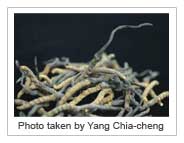 Cordyceps sinensis [Berk] Sacc., also called Ī¦Chinese caterpillar fungusĪ© and literally meaning Ī¦winter worm, summer grassĪ© in Chinese, grows mainly in high cold regions at the altitude of 3,500ĪV5,000 meters above sea level in northwestern parts of China and on the Qinghai-Tibet Plateau in southwestern parts of China. It is found most abundantly in Sichuan Province, but the Cordyceps sinensis grown on the Qinghai-Tibet Plateau offers better quality.
Cordyceps sinensis [Berk] Sacc., also called Ī¦Chinese caterpillar fungusĪ© and literally meaning Ī¦winter worm, summer grassĪ© in Chinese, grows mainly in high cold regions at the altitude of 3,500ĪV5,000 meters above sea level in northwestern parts of China and on the Qinghai-Tibet Plateau in southwestern parts of China. It is found most abundantly in Sichuan Province, but the Cordyceps sinensis grown on the Qinghai-Tibet Plateau offers better quality.
Strictly speaking, Cordyceps sinensis is a complex of parasitic fungus of Cordyceps sp. and its host insect, the larva of Hepialus armoricanus Oberthur. Hepialus armoricanus Oberthur is a completely metamorphosed insect that prefers to live in cold environments. The larva of Hepialus armoricanus Oberthur must spend five years in soil and then go through the pupal stage before metamorphosing into a caterpillar. The diagram below illustrates the life cycle of Cordyceps sinensis: in the summer when the larvae are most active, they crawl out of soil and feed themselves on barks and grass roots to store energy and then crawl back into soil to spend the winter underground. The adult Hepialus armoricanus Oberthur also mates in summertime and lays eggs on the surface layer of soil. When the eggs are hatched into larva after one month, the larva crawls into the loose moist soil. Just when the larvae are most active at the top layer of soil, they are also most susceptible to infection by Cordyceps. The possible infection process is that Cordyceps spores spread in the air are flushed into the soil by moistures from the rain or dews, and adhere to the pores of larvae and invade their bodies (Step 1).
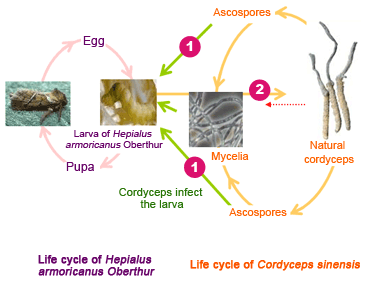
When winter comes, the Cordyceps-infected larvae would penetrate back into the soil to pass the winter there, during which time the spores inside the body of the young insect start to germinate and absorb nutrients from the insectĪ”s internal organs to grow into mycelia and undergo rapid reproduction while decomposing the body of the larva as nutrients. The mycelia gradually grow, spread and finally infiltrate the entire body of the larva, causing its death. At this stage, it is dubbed Ī¦winter worm.Ī© In the following summer when weather warms up, the mycelia grow out of the head of dead larva into grass-like fruiting body/stroma with slightly enlarged tubular sac at the end which contains fungal spores inside. It is called Ī¦summer grassĪ© at this time (Step 2).The mature spores are released into the air from the sac and spread by wind to look for other larva host to complete the sexual generation of Cordyceps sinensis.
There are about 350ĪV400 known species of fungus under genus Cordyceps. Some cordyceps live in the larva or pupa of insect or arthropod, such as cicada, moth, ant, bee, and grasshopper. Cordyceps that are parasitic on cicada are called Cordyceps cicadae, while cordyceps that are parasitic on the pupa of noctuidae insect are called Cordyceps militaris. However, those species are not genuine Cordyceps sinensis. We determine whether a cordyceps species is genuine Cordyceps sinensis by matching the chromatogram of its active ingredients with that of natural Cordyceps sinensis and its genetic sequence. Naturally, different parasitic species and different hosts would produce different efficacy.
Taiwan does not have the suitable natural environment for the growth of Cordyceps sinensis, while China has implemented The Administrative Regulations on the Collection of Caterpillar Fungus Resources and other regulations to protect caterpillar fungus and ban indiscriminate harvesting. Such measures aim to ensure the sustainability of the precious resources of wild caterpillar fungus. But it also makes natural caterpillar fungus a rare, valuable and rather expensive commodity. Although wild Cordyceps sinensis is expensive and hard to come by, we are now able to separate spores or mycelia from wild cordyceps, inoculate them on artificial medium and culture them under proper temperature. The mycelia in this stage do not produce the fruiting body, hence developing an Ī¦asexual generationĪ© of Cordyceps sinensis.
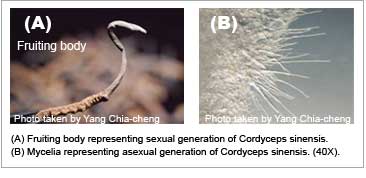
The asexual culture of Cordyceps sinensis involves the use of modern biotechnology to reproduce the Ī¦authenticĪ© growth environment for the medicinal material and cultivating the right species. For instance, Cordyceps militaris is not genuine Cordyceps sinensis. What we do is we first use a molecular biotechnology approach to identify the origin and quality of Cordyceps sinensis, let it grow in nourishing water that contains sufficient minerals and the right trace elements under the right temperature and humidity, and then finally go through the right concoction or processing procedure to obtain genuine medicinal material with bioactivity.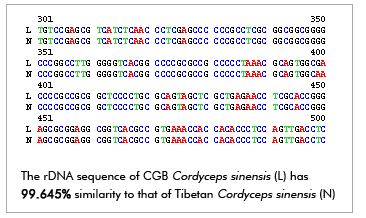
We find some very interesting and real phenomena in the growth pattern of Cordyceps sinensis mycelia. When we use commercially available culture medium (for contrast) and culture medium added with sufficient minerals and the right trace elements to cultivate the Cordyceps, we observe starkly different mycelia growth pattern.
We find that under the authentic primary living environment of Cordyceps sinensisĪXthat is, in nourishing water containing sufficient minerals and the right trace elements and under the right temperature and humidityĪXthe Cordyceps grows actively with full and robust colonies. In longitudinal section, we observe the continual downward growth of mycelia and robust division and branching, indicative of the importance of authentic environment for the growth of Cordyceps sinensis or in fact any dietary or medicinal mushroom and Chinese medicinal herbs.
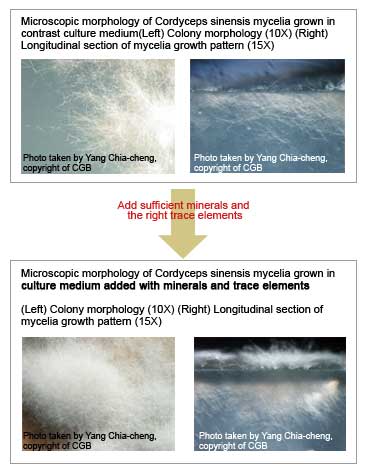
Cordyceps sinensis is considered a precious herbal regimen mainly because it contains many active ingredients, including ribonucleosides, mannitol, sterols, organic acids, polysaccharides, proteins and polyamines, amino acids, dismutase, dipeptides, vitamins and a variety of trace elements. The HPLC chromatograms below show the similarity between the chemical fingerprints of fermented mycelia of Hirsutella sinensis and those of natural Cordyceps sinensis. It is worth noting that most merchants use the content of cordycepin and cordycepic acid as the quality indicators of Cordyceps sinensis. Probably unknown to most merchants and consumers, natural Cordyceps sinensis does not contain cordycepin, which is just another name for 3-deoxy-adenosine that is fairly common and does not warrant in-depth research. This misconception leads many people to believe that only Cordyceps sinensis with high content of cordycepin is good and genuine. Cordycepic acid is just another name for D-mannitol, which is an inexpensive and easily available food additive. Chang Gung Biotechnology uses the HPLC chemical fingerprinting of natural Cordyceps sinensis produced in Tibet to benchmark the quality of Cordyceps sinensis mycelia produced in fermentation process to insist on and assure the authentic quality of our products.
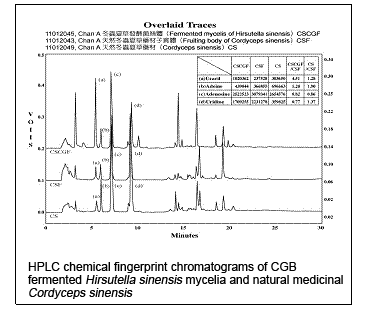
In this article, we have discussed the origin and life cycle of Cordyceps sinensis, talked about the difference between sexual generation and asexual generation, and introduced the growth pattern of asexual generation mycelia, the importance of the authentic environment for its growth, and the chromatography of active ingredients. We hope this article will help the readers gain deeper understanding of Cordyceps sinensis and its fermented mycelia.